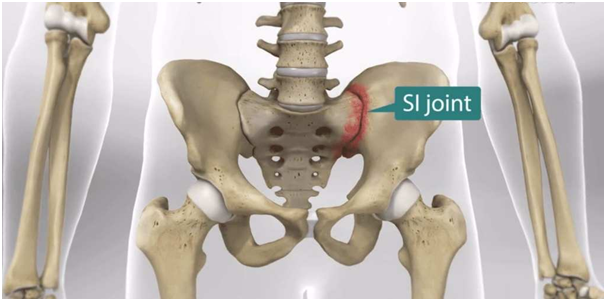| Category | Spinal (Back Pain) |
The sacroiliac joint is a large joint in your lower back and buttocks region. When the joint becomes painful, it can cause pain in its immediate region or it can refer pain into your groin, abdomen, hip, buttock or leg.

Sacroiliitis is the inflammation of one or both of your sacroiliac joints. These two joints are located where the sacrum (the triangular last section of the spine) meets the ilium (a part of the pelvis).
Sacroiliitis is a common source of lower back pain or pain in the buttocks or thighs.
Inflammation of the sacroiliac joint causes most of the symptoms of sacroiliitis. Many medical conditions cause inflammation in the sacroiliac joint, including:
Osteoarthritis -This type of wear-and-tear arthritis can occur in the sacroiliac joints and results from the breakdown of ligaments.
Ankylosing spondylitis - This is a type of inflammatory arthritis of the joints of the spine. Sacroiliitis is often an early symptom of ankylosing spondylitis.
Psoriatic arthritis - This inflammatory condition causes joint pain and swelling as well as psoriasis (scaly patches on the skin). Psoriatic arthritis can cause inflammation of the spinal joints, including the sacroiliac joints.
Trauma - A fall, motor vehicle accident or another injury to the sacroiliac joints or the ligaments supporting or surrounding the sacroiliac joint can cause symptoms.
Pregnancy - Hormones generated during pregnancy can relax the muscles and ligaments of the pelvis, causing the sacroiliac joint to rotate. The weight of pregnancy can also stress the sacroiliac joint and lead to wearing of the joint.
Pyogenic sacroiliitis - This is a rare infection of the sacroiliac joint caused by the bacteria Staphylococcus aureus.
Common symptoms of sacroiliitis include pain that:
We will look for the source of your pain and discomfort. This will involve checking your nerve function and muscle strength, and whether you feel pain when moving or touching the affected area. We also will ask you about your medical history and your symptoms.
Imaging tests can help view the bones and muscles of your spine and identify any damaged areas. Examples of imaging scans include:
We can combine all these pieces of information to determine what is causing your pain, weakness, or discomfort.
Physical therapy. This treatment helps strengthen and stabilize the muscles surrounding your sacroiliac joints. Physical therapy also makes it easier for you to move your sacroiliac joints through full range of motion.
NSAIDs to help manage pain in the early stages of sacroiliitis.
Injection of steroids into your sacroiliac joints to help decrease inflammation and pain.
Radiofrequency ablation is considered only if pain relief is temporarily achieved after sacroiliac joint injection. This procedure uses radio waves to heat a small area of nerve tissue to stop it from sending pain signals, thereby reducing pain.
A sacroiliac joint injection serves several purposes. First, by placing numbing medicine into the joint, the amount of immediate pain relief you experience will help confirm or deny the joint as a source of your pain. Furthermore, time-release cortisone will be injected into the joint to reduce any presumed inflammation and provide long-term pain relief.
Sacroiliac joint injections work powerfully to reduce your inflammation and they can provide months of relief.
The doctor will clean the area over the back and insert a small needle into the target area under imaging guidance. When it is in the correct position, they will inject the drug. They will remove the needle and cover the injection site with a small dressing.
We have very fast and competent working team (Consultant, fellow, clinical assistant, technician and ward assistant) which provide you comfortable atmosphere and ease your nerves. Usual time of stay is few hours
Every procedure carries a risk, although this is extremely small. The risk of infection with this procedure is extremely small as no incisions are made in the skin.
You can resume your work after 1 day if existing disease allows.